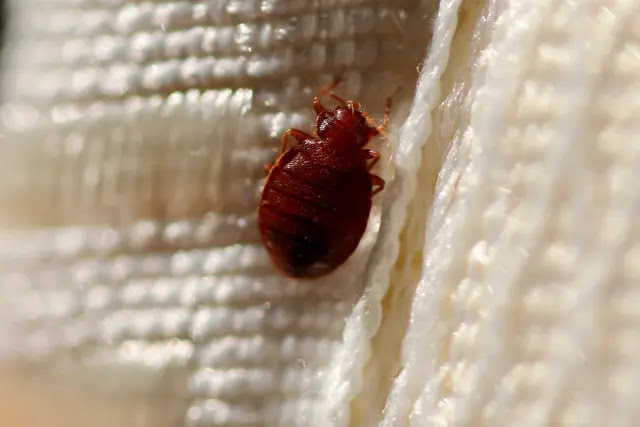It is a common misconception that bed bugs live in dirty places. The reality is that bed bugs are not attracted to dirt, filth, or clutter. Rather, these wingless insects are attracted to warmth, blood, and carbon dioxide. So, as long as you're alive, warm, and breathing – you are a powerful magnet for bed bugs.
Finding bed bugs is as big a problem as eliminating them. These pesky pests have a reputation for their ability to stay out of sight. On top of that, they multiply rapidly, and their population can grow exponentially, making it difficult to eliminate them. Perhaps you're suspecting bed bugs on curtains? Well, bed bugs can hide anywhere, including on your high-end curtains and drapes.
{tocify} $title={Table of Contents}
Can Bed Bugs Live on Curtains?
Bed bugs don't just lay their eggs anywhere. They prefer safe, secure, and dark places where they can create a nest for their eggs. Although curtains do not offer darkness, bed bugs can live and lay eggs on them because they provide safety. But curtains are usually the last resort.
Generally, bed bugs can live on any curtains and drapes made of fabric. However, these pests are typically photophobic. So curtains are the least preferred place for bed bugs to hide because they're usually placed where sunlight enters the room. Besides, bed bugs prefer to live near their host; that's why they are commonly found in mattresses and not on curtains.
Do Bed Bugs Like Curtains?
Bed bugs feed on nothing else except the blood of warm-blooded animals. And they mainly prefer sucking human blood. Hence, they gravitate towards people who remain inactive (e.g. during sleep) long enough for them to suck blood and then crawl away unnoticed.
Bed bug body shape and legs do not allow them to clamber. That's why they naturally prefer to live near their host, for instance, in bed clothing, in bed frames, and behind headboards. So to answer your question, no, bed bugs do not like curtains. In other words, it's not the first place they'd pick.
According to research published in the Journal of Travel Medicine, bed bugs can live on curtains. When the infestation grows extensively, bed bugs are forced to branch out to other less ideal hiding spots – curtains and drapes are one such place.
There are multiple reasons why bed bugs don't prefer curtains:
- Curtains are often far from their host.
- They usually get a lot of sunlight on them.
- Air movement causes curtains to move more often than bed bugs would like.
That said, there's a chance that bed bugs will start living on your curtains. This is especially true if the curtains are rarely disturbed and your bed is placed against a window.
Why Do Bed Bugs Infest Curtains?
As mentioned earlier, curtains are not a preferred place for bed bugs to hide/live. So, there has to be a good reason for these opportunistic pests to infest your curtains. Finding bed bugs on curtains may be a sign that you're dealing with a full-blown infestation. This could mean that your bed and other resting places like couches and reception seats are already heavily infested.
Another reason bed bugs venture to your curtains is because of their bizarre – if not horrific - mating behavior. Bed bugs have a mating habit scientifically referred to as 'traumatic insemination.' A male bed bug climbs onto a female and stabs her body at any location on her abdomen with his hypodermic penis. This creates a wound into which the male releases his sperm directly into her body cavity.
Although one male can provide a female with enough sperm to lay at least one fertilized egg per day, she's often mated repeatedly by several males. Traumatic insemination is a painful and risky mating behavior that wounds the female body, often leaving scars.
Hence, a female who has been inseminated will leave the harborage to find a new shelter and avoid the horrific stabbings. Females also roam to new territories to lay their eggs in a place that is less likely to be disturbed. That's when you start seeing bed bugs on curtains and in other ill-suited places like stuffed animals, purses, and fluorescent light bulbs.
How Do Bed Bugs Get On Curtains?
Because of their body shape and legs, bed bugs are not the best climbers. They need to grip onto jagged features in order to climb surfaces. These blood suckers can climb rough walls, wooden surfaces, and even fabrics but cannot climb a smooth and clean surface.
So, if you have a rough wall surface, bed bugs will climb up the wall to reach your curtains. Bed bugs' crawling prowess also allows them to crawl from the bed, across the floor, and to your curtains. This is especially the case when your curtain ends are touching the floor. Bed bugs are also known to live and hide in carpets and baseboards, making it easy for them to climb from these spots directly to the curtain.
Can Bed Bugs Live in Net Curtains?
Bed bugs can live in your net curtains. That's right. The net curtain fabric is often bunched up to give a generous and gathered look. Bed bugs tend to like the bunched-up top, folds, and tied sides of net curtains as they provide a good place to hide.
But again, bed bugs hate sunlight. In fact, the UV rays emitted by the sun can kill these pesky pests on contact. So, they'll do anything to avoid sunlight and remain in complete darkness. Net curtains allow more light to pass through than drapes. Hence, bed bugs are not attracted to net curtains and will only live in them if the window hardly receives sunlight.
What About Shower Curtains?
Unlike your regular drapes, shower curtains aren't made of fabric. Instead, they are made of a durable type of plastic known as polyvinyl chloride (PVC). PVC transparent curtains have a completely flat and smooth surface. They do not have jagged features for bed bugs to hook their feet in order to climb. In fact, these curtains are often used in offices and halls to keep pests away.
On top of that, bed bugs don't like water, and they don't need to drink it to survive. It is safe to say that bed bugs hate water and will try to avoid it as it represents a threat to them and their eggs. Since shower curtains are placed next to a water source, bed bugs would rather wander off to a drier place.
Can Bed Bugs Lay Eggs in Curtains?
Female bed bugs typically find safe, secure, and dark places to lay their eggs. They prefer locations that are not frequently disturbed and offer easy access to humans for regular feeding. Normally, a bed bug will gorge on blood for 3-10 minutes until it's filled with enough blood to last 3-7 days before retreating to its hiding spot.
The best place for bed bugs to lay their eggs is on or near your bed. However, female bed bugs need to look for a place where no bed bugs live to avoid being mated while laying their eggs. They move away from their current harborage to find a suitable place to lay their eggs.
They can choose to lay their eggs in your curtains, especially drapes, because they are made of fabric. Bed bug eggs are coated with a sticky substance that dries after the eggs are deposited, causing them to adhere to the curtain. After successfully laying all their eggs, female bed bugs will need to feed and mate again to reproduce. Sometimes, a female can even mate with her own offspring, exponentially expanding the infestation.
Where Do Bed Bugs Hide in Curtains?
Bed bugs are small wingless pests that can hide in many places in your home and go unnoticed. Their tiny size and unique ability to flatten their bodies allow them to hide in places where you can hardly see them. When they infest your curtains, bed bugs prefer to hide in places like crevices and folds.
Pay keen attention to the following areas if you're trying to find bed bugs on curtains:
- The hem at the bottom of your curtain, especially if it's touching the floor or walls.
- The sides of your curtain. They have stitches and folds, which offer a safe place for bed bugs to hide.
- Wooden curtain rods. If you have a serious bed bug infestation, high chances are that you'll spot a few of them on your curtain rods. Aluminum rods have a smooth surface, so you'll hardly see bed bugs there.
- Hooks and rings. This is the least preferred place for bed bugs to hide. But if you the bugs at the top end of your curtain, you should also inspect the rings.
How to Get Rid of Bed Bugs On Curtains
Use a Vacuum Cleaner: This old-school method is one of the best ways to get rid of bed bugs on curtains. Once you see bed bugs, use the vacuum cleaner to suck them off and their eggs. Be sure to secure the cleaner bag and dump it a good distance from your home.
Launder Your Curtains: The easiest way to get rid of bed bugs on curtains is by laundering them. Bed bugs can't swim, and once they're submerged in water, they will not be able to resurface. To kill all the bed bugs and their tiny eggs, you'll need to use a detergent and ensure the washing machine is not overloaded. But before you wash, you must check the tags and read the washing instructions to ensure your curtains can be laundered safely.
Steam Iron: Bed bugs and their eggs cannot survive high heat. An adult bed bug will die when exposed to 115 degrees Fahrenheit while its heat-resistant eggs can be destroyed at 120 °F. They need to be exposed constantly to that temperature for at least 90 minutes in order to reach complete mortality. Steam ironing can help get rid of bed bugs on curtains. But you must be careful since curtain materials are delicate and can easily get damaged.
Expert Tips to Repel and Avoid Bed Bugs On Curtains
The best way to keep bed bugs away from your curtains is by bug-proofing them. Here are effective tips to make your curtains inhospitable to pests, including bed bugs:
- Ensure the ends of the drapes are not touching the ground. This makes it hard for bed bugs and other pests to reach them.
- Consider buying curtains that are not made of fabric. For instance, you can buy PVC strip curtains for your office as they are an effective way to limit pests and contaminants on your premises.
- Buying curtains that aren't bunched up reduces the possible hiding spots for bed bugs.
- Use bed bug spray. Pesticides are lethal to bed bugs. You can spray your curtains with an effective bed bug spray to flush the pests out of hiding and kill them together with their eggs. Most bed bug sprays have residual activity, meaning they will continue repelling bed bugs for a long time.
- Call pest control experts: Repelling bed bugs from curtains only solves the problem temporarily. In fact, this encourages them to look for other harborages within your room, worsening the infestation. Pests experts are highly trained to inspect your home, identify the level of the infestation, and permanently get rid of the problem while minimizing the chances of future infestations.
Recommended reading:




